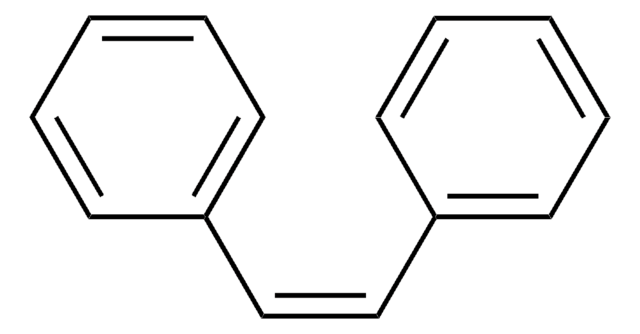223999
2,5-Bis(5-tert-butyl-benzoxazol-2-yl)thiophene
suitable for scintillation, 99%
Synonym(s):
BBOT
Sign Into View Organizational & Contract Pricing
Select a Size
All Photos(3)
Select a Size
Change View
About This Item
Empirical Formula (Hill Notation):
C26H26N2O2S
CAS Number:
Molecular Weight:
430.56
Beilstein/REAXYS Number:
631803
EC Number:
MDL number:
UNSPSC Code:
12171500
PubChem Substance ID:
NACRES:
NA.47
Recommended Products
Quality Level
assay
99%
form
powder
technique(s)
titration: suitable
color
yellow to green
mp
199-201 °C (lit.)
solubility
toluene: 50 mg/mL
density
1.272 g/cm3 at 20 °C
ε (extinction coefficient)
≥47000 at 372-374 nm in dioxane
suitability
suitable for scintillation
Looking for similar products? Visit Product Comparison Guide
Related Categories
General description
2,5-Bis(5-tert-butyl-benzoxazol-2-yl)thiophene known as BBT is a commercially available safe fluorescent brightener. It is a light-emitting chemical compound that is a benzoxazole derivative. The molecule has excellent UV-Visible absorption property and outstanding fluorescent ability. These physical properties allow them to act as high-performance photoinitiators. It is a commercially available safe fluorescent brightener. The molecule has excellent UV-Visible absorption property and outstanding fluorescent ability.
Application
2,5-Bis(5-tert-butyl-benzoxazol-2-yl)thiophene is usually used as an optical brightener. It is suitable for photoluminescence experiments on doped silica films. It is also suitable to visualize ultraviolet (UV)-patterned acrylic pressure-sensitive adhesives.
related product
Product No.
Description
Pricing
Storage Class
11 - Combustible Solids
wgk_germany
WGK 1
flash_point_f
Not applicable
flash_point_c
Not applicable
ppe
Eyeshields, Gloves, type N95 (US)
Choose from one of the most recent versions:
Already Own This Product?
Find documentation for the products that you have recently purchased in the Document Library.
Sudha M Srinivasan et al.
Review journal of autism and developmental disorders, 5(2), 156-175 (2018-10-16)
Literature on effects of equine therapy in individuals with autism spectrum disorder (ASD) has grown in recent times. Equine therapy is an alternative multimodal intervention that involves utilizing a horse to enhance core impairments in ASD. Recent systematic reviews in
Giuseppe Ferrara et al.
Frontiers in plant science, 9, 1374-1374 (2018-11-14)
Little information is available about nitrogen (N) content and its concentration in table grape vines. Knowledge of the quantity of N accumulated by the vine organs during the season could support sustainable fertilization programs for table grape vineyards. The aim
Jun-Ling Wang et al.
Guang pu xue yu guang pu fen xi = Guang pu, 29(7), 1740-1744 (2009-10-06)
Thin nano-porous silica films doped with high concentrations of fluorescent material, 2, 5-bis (5-tert-butyl-2-benzoxazolyl)-thiophene (BBOT) were prepared via a sol-gel process. Uniform and bright blue fluorescence was observed. Light emission properties of these organic molecule doped inorganic silica films, i.e.
Yin Zheng et al.
International journal of nanomedicine, 11, 5971-5987 (2016-11-24)
Nanoemulsions (NEs) are used as transdermal drug delivery systems for systematic therapeutic purposes. We hypothesized that the skin permeation profile of an NE could be modulated by incorporating it into a hydrogel containing differing proportions of thickening agent. The objectives
Eva E Stüeken et al.
Rapid communications in mass spectrometry : RCM, 34(18), e8821-e8821 (2020-05-03)
Elemental abundances and isotopic ratios of carbon, nitrogen, sulfur and hydrogen have become important tools for reconstructing the evolution of Earth and life over geologic timescales, requiring accurate and precise analytical methods with high sample throughput. However, these measurements may
Our team of scientists has experience in all areas of research including Life Science, Material Science, Chemical Synthesis, Chromatography, Analytical and many others.
Contact Technical Service








